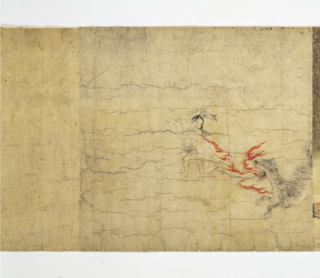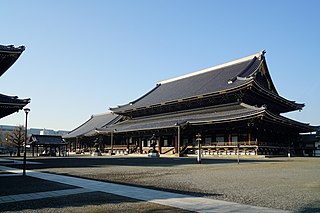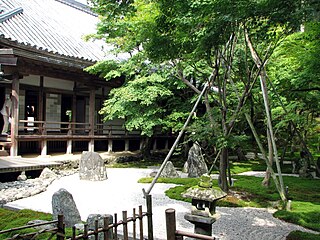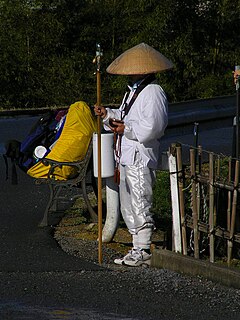 W
WWalter Andrews was an Anglican bishop in Japan in the first third of the twentieth century.
 W
WAtago Gongen (愛宕権現) is a Japanese kami believed to be the local avatar (Gongen) of Buddhist bodhisattva Jizō. The cult originated in Shugendō practices on Mount Atago in Kyoto, and Atago Gongen is worshiped as a protector against fire. There are some nine hundred Atago Shrines around Japan.
 W
WThe Roman Catholic Diocese of Fukuoka is a diocese located in Fukuoka in the Ecclesiastical province of Nagasaki 長崎 in Japan.
 W
WGokuraku-ji (極楽寺) is a Buddhist temple of the Shingon sect located in Kamakura, Kanagawa Prefecture, Japan. It was founded in 1259 by Ninshō (1217-1303) and has been restored and rebuilt many times since then.
 W
WGyoran-ji (魚藍寺), formal name Suigetsu-in Gyoran-ji (水月院魚藍寺), is a Buddhist temple in 4 Mita, Minato, Tokyo, Japan. It is located in the mountain side of Tsuki no Misaki.
 W
WHanawa Hokiichi was a Japanese blind kokugaku scholar of the Edo period.
 W
WHatsumōde is the first Buddhist temple or Shinto shrine visit of the Japanese New Year. Many visit on the first, second, or third day of the year as most are off work on those days. Generally, wishes for the new year are made, new omamori are bought, and the old ones are returned to the shrine so they can be burned. There are often long lines at major shrines throughout Japan.
 W
WHell Scroll is a scroll depicting seven out of the sixteen lesser hells presented in Kisekyō. Six of the paintings are accompanied by text, which all begin with the phrase "There is yet another hell", following a description of what the sinners depicted did to end up in this particular hell.
 W
WHigashi Hongan-ji (東本願寺), or, ″the Eastern Monastery of the Original Vow″, is one of two dominant sub-sects of Shin Buddhism in Japan and abroad, the other being Nishi Honganji. It is also the name of the head temple of the Ōtani-ha branch of Jōdo Shinshū in Kyoto, which was most recently constructed in 1895 after a fire burned down the previous temple. As with many sites in Kyoto, these two complexes have more casual names and are known affectionately in Kyoto as Onissan and Ohigashisan .
 W
WThe Roman Catholic Diocese of Hiroshima is a diocese located in the city of Hiroshima in the Ecclesiastical province of Osaka 大阪 in Japan.
 W
WInternational College for Postgraduate Buddhist Studies is a private university in Minato, Tokyo, Japan, established in 1996. The university offers only one program, a Ph.D program in Buddhism, and only 20 students are enrolled into the program.
 W
WKaidan-in (戒壇院) is a Rinzai temple in Dazaifu, Fukuoka Prefecture, Japan. It was founded by Ganjin in 761.
 W
WKasadera Kannon, also known as Ryūfuku-ji (笠覆寺) is a Buddhist temple located in Minami-ku, Nagoya in central Japan.
 W
WKatsuō-ji is a Buddhist temple in Minō city, north of Osaka, Japan.
 W
WKawasaki Daishi (川崎大師) is the popular name of Heiken-ji , a Buddhist temple in Kawasaki, Japan. Founded in 1128, it is the headquarters of the Chizan sect of Shingon Buddhism. Kawasaki Daishi is a popular temple for hatsumōde. In 2006, 2.72 million people engaged in hatsumōde here, the third largest figure in Japan and the largest in Kanagawa Prefecture. In 2016, the temple made preparations to receive 3 million visitors over the same period. Keihin Electric Express Railway, the oldest railroad company in the Kantō region of Japan, commenced service in January 1899 to carry passengers to Kawasaki Daishi from Tokyo.
 W
WKegon is the Japanese transmission of the Huayan school of Chinese Buddhism.
 W
WKisshō-ji, also Kichijō-ji is a Buddhist Temple located in Bunkyo, Tokyo, Japan. It was founded in 1458, during the Muromachi period.
 W
WKisshōten, also known as Kichijōten, Kisshoutennyo (吉祥天女), Kudokuten (功徳天) is a Japanese female deity. Adapted via Buddhism from the Hindu goddess Lakshmi. Kisshoutennyo is sometimes named as one of the Seven Gods of Fortune (fukujin), replacing either Jurōjin or Fukurokuju. For example, in the 1783 edition of the Butsuzōzui compendium, Kichijōten replaces Fukurokuju as one of the seven fukujin. She is considered to be the goddess of happiness, fertility, and beauty. Kisshoutennyo's iconography is distinguished by the Nyoihōju gem (如意宝珠) in her hand, Kisshōten and the Nyoihōju gem are both represented by the symbol of the kagome.
 W
WKōfuku-ji or Tōmeizan Kōfuku-ji is a Buddhist temple of the Ōbaku school of Zen established in 1624 in Nagasaki, Japan. It is an important cultural asset designated by the government.
 W
WKōken-ji (高顕寺) is a Buddhist temple of the Kōyasan Shingon school located in Bizen, Okayama Prefecture, Japan.
 W
WKompira is a Japanese god of the Shugendō sect originating in the mountain Kotohira of Kagawa Prefecture. Kompira is the god of merchant sailors.
 W
WKōmyōzen-ji (光明禅寺) is a Zen temple in Dazaifu, Fukuoka Prefecture, Japan. It was founded by Tetsugyū Enshin of the Tōfuku-ji Rinzai school in 1273. Kōmyōzen-ji is celebrated for its karesansui garden, the only example in Kyushu.
 W
WKongōbu-ji (金剛峯寺) is the ecclesiastic head temple of Koyasan Shingon Buddhism, located on Mount Kōya , Wakayama Prefecture, Japan. Its name means Temple of the Diamond Mountain Peak. It is part of the "Sacred Sites and Pilgrimage Routes in the Kii Mountain Range" UNESCO World Heritage Site.
 W
WA kumbhāṇḍa (Sanskrit) or kumbhaṇḍa (Pāli) is one of a group of dwarfish, misshapen spirits among the lesser deities of Buddhist mythology.
 W
WThe Roman Catholic Diocese of Kyoto is a diocese located in the city of Kyoto in the Ecclesiastical province of Osaka 大阪 in Japan.
 W
WMitsu-gusoku in Japanese Buddhism is a traditional arrangement of three articles, often displayed in front of a painting of the Buddha or important Buddhist figures.
 W
WThe Roman Catholic Archdiocese of Nagasaki is an archdiocese located in the city of Nagasaki in Japan.
 W
WThe Roman Catholic Diocese of Nagoya is a diocese of the Western Latin Rite of the Catholic Church that is centered in the city of Nagoya and is part of the ecclesiastical province of Roman Catholic Archdiocese of Osaka 大阪 in Japan.
 W
WŌfuna Kannon Temple is a Buddhist temple in Kamakura, Kanagawa Prefecture, Japan. The outstanding feature of the temple is a 25 metres (82 ft), 1900-ton reinforced concrete statue of the bodhisattva Kannon.
 W
WThe Roman Catholic Archdiocese of Osaka is an archdiocese located in the city of Osaka in Japan.
 W
WThe Paantu festival is an annual festival on the island of Miyako-jima in Japan's Okinawa Prefecture.
 W
WKokubun-ji (国分寺) were Buddhist temples established in each of the provinces of Japan by Emperor Shōmu during the Nara period.
 W
WRinnō-ji (輪王寺) is a Tendai Buddhist temple buildings in the city of Nikkō, Tochigi Prefecture, Japan.
 W
WRisshū (律宗), also Ritsu school, is one of the six schools of Nara Buddhism in Japan, noted for its use of the Vinaya textual framework of the Dharmaguptaka, one of the early schools of Buddhism. The Ritsu school was founded in Japan by the blind Chinese priest Jianzhen, better known by his Japanese name Ganjin. Ganjin traveled to Japan at the request of Japanese priests, and established the Tōshōdai-ji in Nara. During the Kamakura period, the Ritsu sect was divided into schools at Tōshōdai-ji, Kaidan-in, Saidai-ji, and Sennyū-ji. However, during the Meiji period, the Ritsu sect was incorporated within the Shingon sect by decree of the Japanese government. Today only Tōshōdai-ji, which resisted the government measures, retains its identity as a Ritsu temple.
 W
WThe Roman Catholic Diocese of Saitama is a diocese located in the city of Saitama in the Ecclesiastical province of Tokyo in Japan.
 W
WThe Roman Catholic Diocese of Sendai is a diocese of the Western Latin Church of the Catholic Church centered in the city of Sendai. It is within the ecclesiastical province of Roman Catholic Archdiocese of Tokyo in Japan.
 W
WShingaku or Sekimon-shingaku (石門心学) is a Japanese religious movement, founded by Ishida Baigan and further developed by Teshima Toan, which was especially influential during the Tokugawa period. Shingaku has been characterized as coming from a Neo-Confucian tradition, integrating principles from Zen Buddhism and Shinto. It has been speculated, Shingaku was one of the cultural foundations for Japan's industrialization.
 W
WBuzan-ha is a sect of Shingon Buddhism founded in the 16th century by the priest Senyo Sōjō (専誉僧正). The main Buzan-ha temple is Hase-dera in Sakurai, Nara.
 W
WA shuin is a seal stamp given to worshippers and visitors to Shinto shrines and Buddhist temples in Japan. The seal stamps are often collected in books called shuinchō (朱印帳) that are sold at shrines and temples.
 W
WThe Roman Catholic Diocese of Takamatsu is a diocese comprising the island of Shikoku, with its cathedral, Sakuramachi Cathedral Church, located in the city of Takamatsu. It includes the Japanese prefectures of Kagawa, Ehime, Tokushima and Kōchi. The diocese is in the Ecclesiastical province of Osaka 大阪 in Japan.
 W
WTakuhatsu (托鉢) (Pindacara) is a traditional form of dāna or alms given to Buddhist monks in Japan. In the practice of takuhatsu, monks travel to various businesses and residences to chant sutras in Sino-Japanese in exchange for donations of food and money.
 W
WTōkyūjutsu (淘宮術) or Tōdō is a Japanese divination method, created by Yokoyama Marumitsu in the 1830s. It was developed from tengenjutsu, a system with origins in China and was well established at the time. Tōkyūjutsu teaches that ones personality and character can be determined by factors such as the date of birth and facial features. Good fortune is allegedly achieved by finding and understanding this inner self that has been obscured.
 W
WUshiku Daibutsu (牛久大仏) is a statue located in Ushiku, Ibaraki Prefecture, Japan. Completed in 1993, it stands a total of 120 metres (390 ft) tall, including the 10 m (33 ft) base and 10m lotus platform. The statue held the record for the tallest statue from 1993–2008. As of 2018, it is one of the top five tallest statues in the world.
 W
WVajraparamita, also Kongō-Haramitsu (金剛波羅蜜菩薩) is a Bodhisattva of the Buddhist Pantheon, belonging especially to the Esoteric Buddhism tradition of Vajrayana. Kongō-Haramitsu is one of the deities of the Five Mysteries of Vajrasattva, where it appears as one of the four Paramitas. Kongō-Haramitsu is also a central deity of the Buddhist Pantheon of Tō-ji Temple.
 W
WThe Roman Catholic Diocese of Yokohama is a diocese of the Roman Rite of the western Latin Church of the Catholic Church. Its cathedral is located in the city of Yokohama. It is a suffragan diocese of Roman Catholic Archdiocese of Tokyo in Japan and therefore in Tokyo's ecclesiastical province.
 W
WYūtenji is a temple of the Pure Land Sect of Buddhism in Nakameguro, Meguro, Tokyo, Japan.
 W
WZenpuku-ji (善福寺), also known as Azabu-san (麻布山), is a Jōdo Shinshū temple located in the Azabu district of Tokyo, Japan. It is one of the oldest Tokyo temples, after Asakusa.
 W
WZenyōmitsu-ji (善養密寺) is a Buddhist temple in the Setagaya ward of Tokyo, Japan. The temple follows the Shingon creed of Vajrayana Buddhism, which attaches particular importance to the origins of Buddhism and its manifestation throughout history.